Context
Mrągowo is a resort town in the Warmian-Masurian Voivodeship of northeastern Poland, with 21,889 inhabitants (2019). 70% of the heating demand of the Mrągowo municipality is covered by DH. The dominant fuel is hard coal and coal products.
Between 2013-2015, heat production for DH was decreasing in Poland. It is the result of a thermo-modernisation process in existing buildings and limited new market developments. After 2015, the residential investment market grew but new investments partly concentrated on acquiring energy power plants, on a micro-scale. That is why investment in the residential sector, services sector and municipality buildings is increasing.
The direct use of renewables is positive in Poland. The increase in the share of “Heat only Renewables” in the energy supply composition of generated DH results from the inclusion of geothermal heat production.
Compared to the rest of Poland, geothermal has a low potential in Mrągowo.
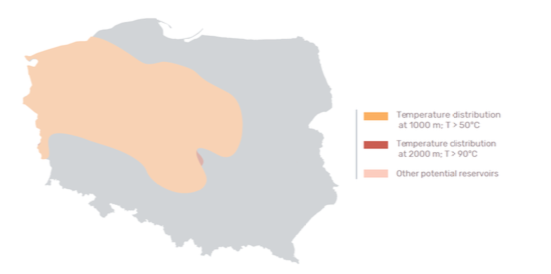
The application of technologies based on biomass will be explored including the possibility to use solar technology in the summer period to support hot water need. The possibility of cooling will be evaluated, as the need of cooling usually is less demanded in that area.
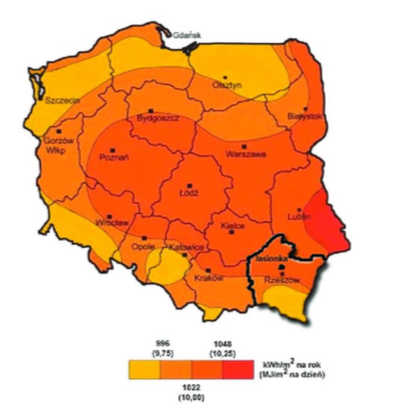
Area
The total number of buildings connected is 247, covering an area of around 416,000 m2.
The city hospital, the city hall, the town hall and primary and secondary schools are heated by the DH based on boilers WR-10, and WR-5, with a total power of 40.7 MW (3 boilers of approximately 10 MW and 3 boilers of approximately 5 MW), with hard coal.
The system is under retrofitting, initiating the process for its substitution of part of the production by biomass technologies.
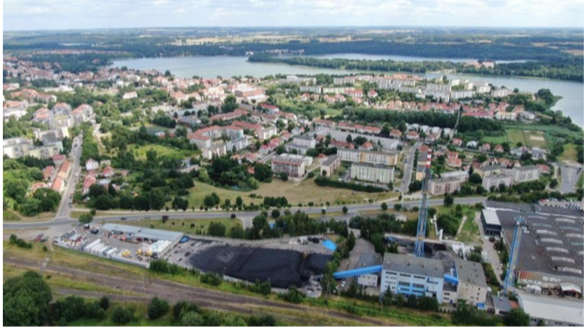
Energy demand
The energy consumption of the DH is approximately 87,000 MWh/year, for a total consumption of 10,500 ton/y of hard coal. For a total capacity of 40.7 MW, the utilisation factor is approximately 2,000 h/y at full capacity. The heating peak demand is 25.5 MW, while the heat water supply peak demand is 1.8 MW. The heat production of the facility will be used for direct heating between 135 and 70 C and hot water between 70 and 45 C.
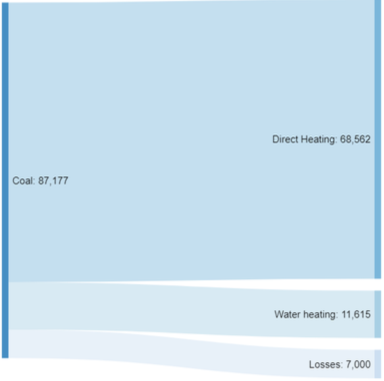
Proposed technologies
Considering the previous information, the technologies and solutions proposed to be studied in Mrągowo are the following

Solar technologies
Integration of solar panels in the central station to cover extra heating load

Molten salt storage
to support cooling options or additional services requiring T > 100 C

Biomass boiler
Biomass boilers installation for thermal energy supply

Cooling alternative
The possibility of cooling alternatives will be evaluated and analysed in detail with WEDISTRICT technologies
Proposed solutions
The combination of the different technologies generates three main solutions which will be studied in the next steps (other solutions might arise during the activity):
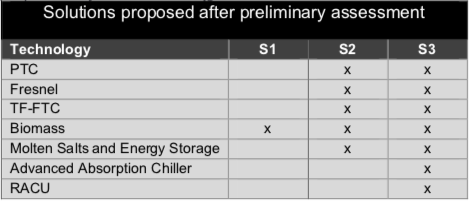
Solution 1
This combination integrates biomass to analyse the upgrade of the DH
Expected Impact
Increase the utilisation factor of existing heaters
Evaluate the availability of biomass and cover extra heating load
Lower significatively CO2 emissions
Solution 2
This combination integrates biomass and solar thermal technologies to the upgrade the DH
Expected Impact
Reduce energy differences between summer and winter
Increase the utilisation factor of existing heaters
Evaluate the possibility of additional solar thermal capabilities to the DH
Evaluate the availability of biomass and cover extra heating load
Solution 3
This combination integrates biomass and solar thermal technologies with advanced WEDISTRICT cooling technologies to analyse the upgrade of the DHC
Expected Impact
Add cooling capabilities to the system
Reduce energy differences between summer and winter
Increase the utilisation factor of existing heaters
Evaluate the possibility of additional solar thermal capabilities to the DHC
Evaluate the availability of biomass and cover extra heating load for cooling
Plan new development of residential buildings with WEDISTRICT cooling technologies
During the next steps, a shift from coal to biomass, or a reduction of excess in capacity will be evaluated.
The evaluation of potential cooling demand will be done to check the viability of DC in the area, especially for non-residential buildings.
The analysis will check the impact of adding additional WEDISTRICT technologies as:
Biomass: to provide additional thermal capacity, or for renewing/retrofitting heat capacity.
Cooling services: adding cooling capabilities, thermal energy will be demanded in summer, requiring the utilisation of gas boilers and additional thermal energy based on solar technologies, if a viability check is positive.
Evaluation of energy storage needs, and implementation based on WEDISTRICT technologies, in case of solar technologies implementation.